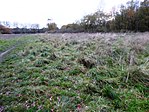Bardon Hill railway station
Disused railway stations in LeicestershireEast Midlands railway station stubsFormer Midland Railway stationsPages with no open date in Infobox stationRailway stations in Great Britain closed in 1952 ... and 2 more
Railway stations in Great Britain opened in 1833Use British English from March 2015

Bardon Hill railway station was a railway station in Leicestershire, England, on the Leicester and Swannington Railway, which later became part of the Midland Railway's Leicester to Burton upon Trent Line. The village of Bardon was built to serve the large granite quarry on Bardon Hill. The quarry has for many decades provided significant freight traffic for the railway, and in about 1990 the village was demolished to let the quarry expand. British Railways had closed Bardon Hill station in 1952 but the line remains open for freight traffic.
Excerpt from the Wikipedia article Bardon Hill railway station (License: CC BY-SA 3.0, Authors, Images).Bardon Hill railway station
Grange Road, North West Leicestershire Hugglescote and Donington le Heath
Geographical coordinates (GPS) Address Nearby Places Show on map
Geographical coordinates (GPS)
| Latitude | Longitude |
|---|---|
| N 52.7097 ° | E -1.3465 ° |
Address
Grange Road
Grange Road
LE67 1TH North West Leicestershire, Hugglescote and Donington le Heath
England, United Kingdom
Open on Google Maps





